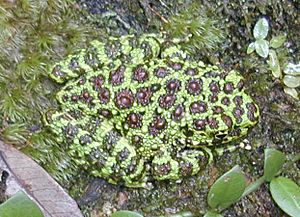True frog facts for kids
Quick facts for kids True frogs |
|
|---|---|
 |
|
| Common frog, Rana temporaria | |
| Scientific classification | |
| Subfamilies | |
|
See text |
|
| Synonyms | |
|
Ceratobatrachidae |
The true frogs belong to a large family called Ranidae. They are found in more places than any other frog family! You can find them on every continent except Antarctica.
True frogs live in North America, northern South America, Europe, Africa (including Madagascar), and Asia. Some even live in the East Indies and New Guinea. One species, the Australian wood frog, has made its way to northern Australia.
Most true frogs have smooth, moist skin. They have big, strong legs and webbed feet, which help them swim. True frogs come in many different sizes. Some are small, like the wood frog (Lithobates sylvatica). Others are huge, like the goliath frog (Conraua goliath), which is the biggest frog in the world!
Many true frogs live in or very close to water. Most kinds lay their eggs in the water. These eggs hatch into tadpoles, which then grow into frogs. But not all true frogs are the same! Some, like those in the Tomopterna group from Africa, are burrowing frogs. This means they dig into the ground. There are also true frogs that live in trees. Some can even live in brackish water, which is a mix of fresh and salt water. This is very rare for amphibians!
Frog Families and Groups
Scientists are always learning more about how to group different kinds of frogs. The way true frogs are divided into smaller groups is still being discussed. However, many scientists are starting to agree.
For example, the group called Petropedetinae is now often seen as its own separate family, called Petropedetidae. The same goes for the Cacosterninae group. Another group, the Mantellidae, used to be part of the true frog family but is now considered a separate family. Also, the forked-tongued frogs, called Dicroglossidae, are often split off as their own family again.
Scientists are also studying how to best divide the very large group of frogs called Rana. Some smaller groups, like Pelophylax, are now clearly seen as separate. But others, like the American bullfrogs (once called Lithobates), are still debated.
Even though there's still a lot to learn, scientists have identified some main groups within the true frog family.
- Some groups, like Nyctibatrachus and Staurois, are likely very old branches of the true frog family tree.
- The Amolops group is generally seen as a single, related group.
- Odorrana and Rana form another related group.
- There's a group that includes Clinotarsus, Huia, and Meristogenys.
- Other groups like Glandirana, Hylarana, and Pelophylax are still being studied to see how they are all related.
Genera of True Frogs
Here are some of the different groups (called genera) that belong to the true frog family. Scientists are always studying these to understand their relationships better.



- Afrana
- Allopaa
- Amietia
- Amolops
- Anhydrophryne
- Arthroleptella
- Arthroleptides
- Aubria
- Babina
- Batrachylodes
- Cacosternum
- Ceratobatrachus
- Chaparana
- Chrysopaa
- Clinotarsus
- Conraua
- Dimorphognathus
- Discodeles
- Ericabatrachus
- Euphlyctis
- Fejervarya
- Glandirana
- Hildebrandtia
- Hoplobatrachus
- Huia
- Hylarana
- Humerana
- Indirana
- Ingerana
- Lankanectes
- Lanzarana
- Limnonectes
- Lithobates
- Meristogenys
- Micrixalus
- Microbatrachella
- Minervarya
- Nannophrys
- Nanorana
- Natalobatrachus
- Nothophryne
- Nyctibatrachus
- Occidozyga
- Odorrana
- Paa
- Palmatorappia
- Pelophylax
- Petropedetes
- Phrynobatrachus
- Phrynodon
- Platymantis
- Pseudoamolops
- Poyntonia
- Pterorana
- Ptychadena
- Pyxicephalus
- Rana
- Sanguirana
- Sphaerotheca
- Staurois
- Strongylopus
- Tomopterna
See also
 In Spanish: Ránidos para niños
In Spanish: Ránidos para niños

